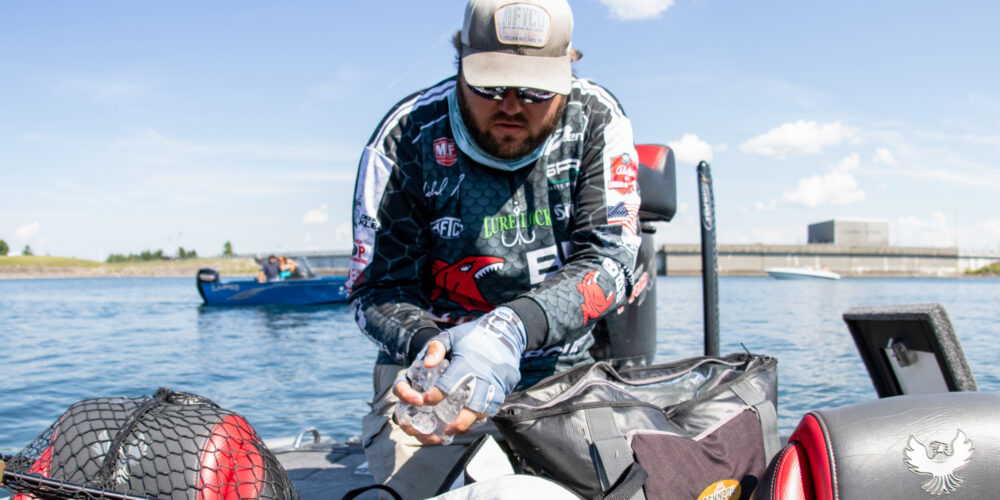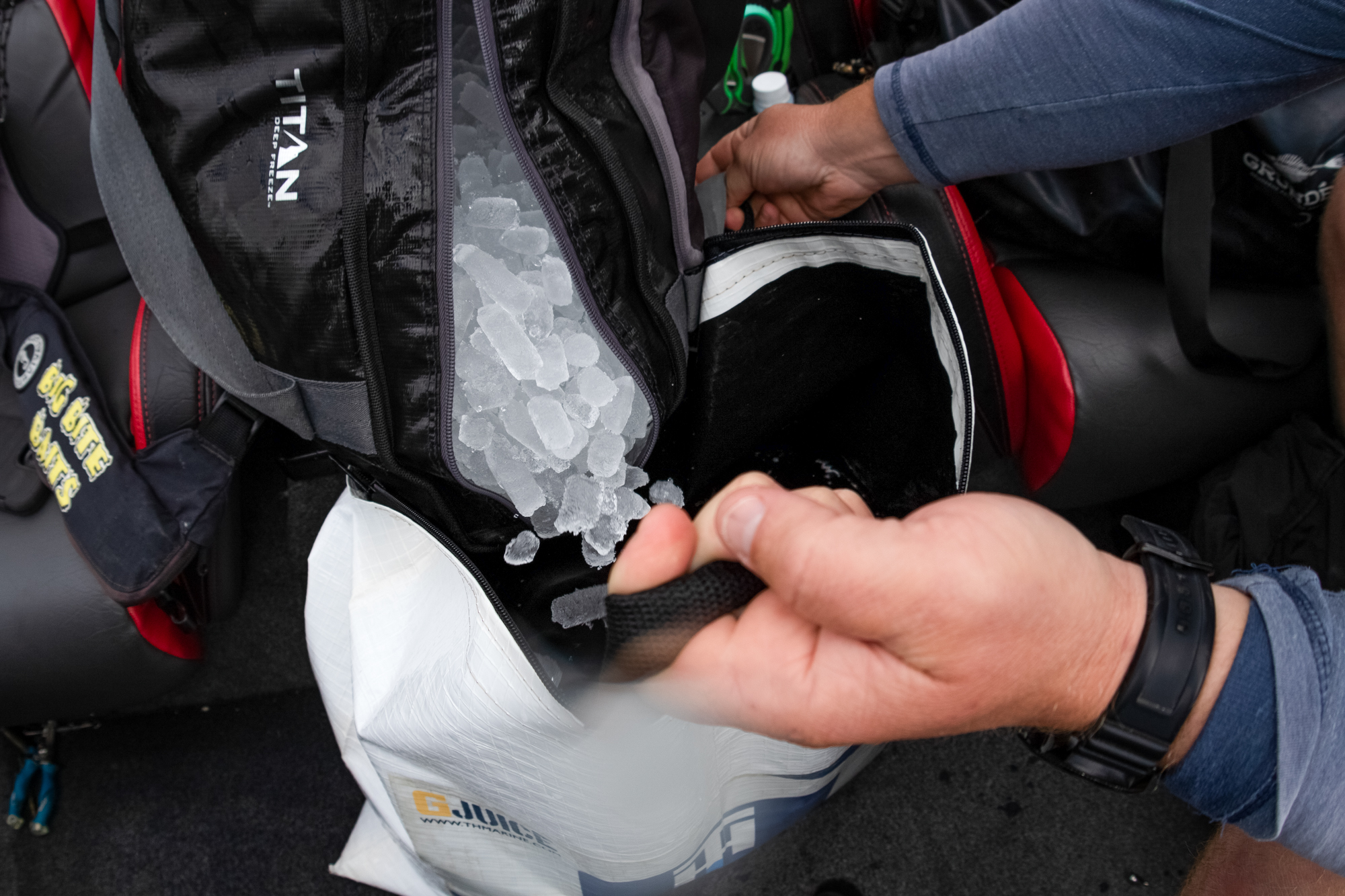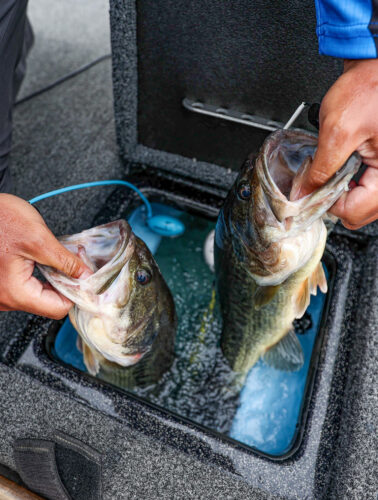Icing your livewell is good summertime fish care, but here are a few tips from MLF pros

Anyone who is competing in a summertime tournament has one thing nagging in the back of their mind – don’t lose a fish. Bringing five alive to the weigh-in scale is the first goal. Thankfully, with livewell innovations (improved pumps, oxygenators and additives), keeping your fish alive is much easier. Still, there are old tricks that can be helpful.
One of those tricks is using ice, but like many things in competitive bass fishing, knowing how to use ice in your livewell is an art perfected over years of trial and error. How much ice do you add, how quickly, or should you even add the ice at all? We asked veteran anglers Edwin Evers, Gary Klein, Paul Elias, and Tommy Biffle to help answer some of these questions and give us their sage advice on icing.
Why icing works
Before we get to what the veterans had to say, let’s start with the basic science behind icing.
There are a couple of reasons adding ice to a livewell is beneficial. First, water technically has the potential to hold more dissolved oxygen (D.O.) at cooler temperatures. In the summer months, the water might hold 4 to 6 parts per million (ppm) of D.O. Dropping below 4 ppm can be stressful for all bass species and below 1 ppm is lethal. By cooling the water temperature and running your recirculation pumps, you can increase the D.O. number by 0.5 to 1 ppm. Additional agitation of the surface water or ventilation of the livewell door can increase the absorption of oxygen even further.

Another benefit of cooling your water is that water quality degrades more quickly at high temperatures. So, cooling the water will reduce the undesirable gases that build up in the livewell water. Most of these come from the respiration of the fish. As their gills absorb oxygen from the water, they are excreting carbon dioxide and ammonia back into the water.
Since fish are ectothermic animals, when you lower the water temperature, you lower their body temperature as well. This means you slow their respiration, heartbeat and metabolism. Slowing their body function slightly allows them to recover more quickly from angling stress and reduces the gas secretion from the gills.
There’s always the chance that you could add too much ice and cold shock your fish as well. Any temperature change over 10 degrees within one hour will cause a fish to stress. If the temperature change is too great or too quick, it can be lethal.
The steps to follow
Adding ice to a livewell of course cools the water; how much it cools the water is determined by the starting water temperature, water volume, ice temperature and the amount of ice you add.
There’s a rough formula used to calculate how much ice you need. Before you can use the formula, you must know the exact gallons of water you have and the temperature change you want to get. Once you have that, use this formula:
(Livewell volume in gallons ÷ by 1,000) x (the number of degrees you want to drop) x 43.75
If you do this for a 40-gallon livewell, with the desire to drop the livewell 5 degrees, you need to add 8.75 pounds of ice. This assumes that you’re using a recently purchased bag of ice that hasn’t had time to thaw for half a day.
We built this handy chart to determine how many pounds of ice is needed in your livewell to drop it the desired degrees.
| Pounds of Ice Needed to Decrease Livewell Temperature by 1-10 ° F | |||||
| 10 gallons | 20 gallons | 30 gallons | 40 gallons | 50 gallons | |
| 1 degree | 0.4 | 0.9 | 1.3 | 1.8 | 2.2 |
| 2 degrees | 0.9 | 1.8 | 2.6 | 3.5 | 4.4 |
| 3 degrees | 1.3 | 2.6 | 3.9 | 5.3 | 6.6 |
| 4 degrees | 1.8 | 3.5 | 5.3 | 7.0 | 8.8 |
| 5 degrees | 2.2 | 4.4 | 6.6 | 8.8 | 10.9 |
| 6 degrees | 2.6 | 5.3 | 7.9 | 10.5 | 13.1 |
| 7 degrees | 3.1 | 6.1 | 9.2 | 12.3 | 15.3 |
| 8 degrees | 3.5 | 7.0 | 10.5 | 14.0 | 17.5 |
| 9 degrees | 3.9 | 7.9 | 11.8 | 15.8 | 19.7 |
| 10 degrees | 4.4 | 8.8 | 13.1 | 17.5 | 21.9 |
Now onto the icing tips from our pros:

Edwin Evers’ icing tips
“In the past, I had a livewell cooling system on my Nitro where I didn’t have to use ice as often. Without the cooling system, I use ice all the time in summer months. I try to cool the livewell 10°F. A lot of times I will add water and ice in the livewell to start the day and re-ice throughout the day to keep the water at a constant temperature.
“At one time, I also had temperature probes in my livewells that would read on my Lowrance screens, which made things very easy. I run my recirculating pumps all day long and at least once or twice a day exchange 50% of the water by running the intake pumps. Everyone must remember it takes a lot to cool the water down and running the fill pumps negates any ice you have added. Probably one of the best practices is having big blocks of ice that melt over time, instead of bagged ice.”
Gary Klein’s icing tips
“I always add ice if the water is over 85°F. I add 5 to 10 pounds in the morning and leave extra ice in the boat to add throughout the day. I run my recirculation pumps constantly, but I try to leave my auto intake off if I’m fishing shallow. Instead, I will run out to deeper water to refill my livewells periodically, this will usually be slightly cooler water.
“You must remember to do it, not refilling will cost you. The biggest mistake people make is putting fish in the livewell then dumping several bags of ice on them and closing the lids to only find them shocked hours later.”
Tommy Biffle’s icing tips
“You must be careful not to shock the fish, so use a little ice at a time. Shocking the fish will kill them and with too much ice, you get the water too cold. I only use it if the water temperature is 85°F or higher and use very little. One thing you can do is take a 32oz bottle, freeze it, and put it in the livewell in the morning to cool it down. I like to run my pumps on high all day and I use hydrogen peroxide all the time. A cap full or small pour will work and I never lose a fish.”
Paul Elias’ icing tips
“I usually start using ice once the water temperature gets in the 78-80°F range. I usually pour about half of a 10-pound bag in after I catch my first fish and then pour the remainder in about 30 minutes later. I add T-H Marine G Juice or Sure-Life Catch and Release after the first fish. I use aeration pumps throughout the day. The main thing is not to add so much ice that you shock the fish. I keep an extra bag of ice in a small cooler in case it’s needed.”
MLF Fisheries Management Division’s livewell-icing tips
- Know your livewell water capacity.
- Monitor the surface water and livewell temperatures throughout the day.
- Start using ice when surface temperatures are continuously above 75°F
- Increase your frequency of adding ice and do partial water changes as water temperatures increase above 80°F.
- Never attempt to drop the livewell water temperature more than 5 degrees at one time.
- If possible, use large block ice or frozen water bottles to slowly lower the temperature over several hours.
- Re-ice after you add new water to maintain a constant livewell temperature.
- As water temperatures increase above 85°F, add fresh water more frequently to avoid degrading water quality.